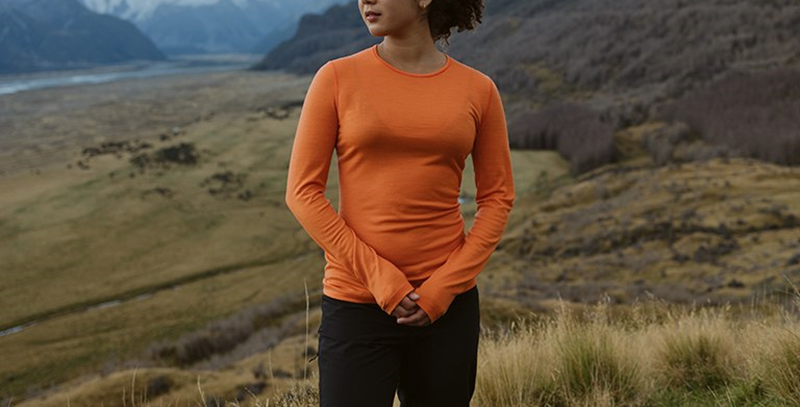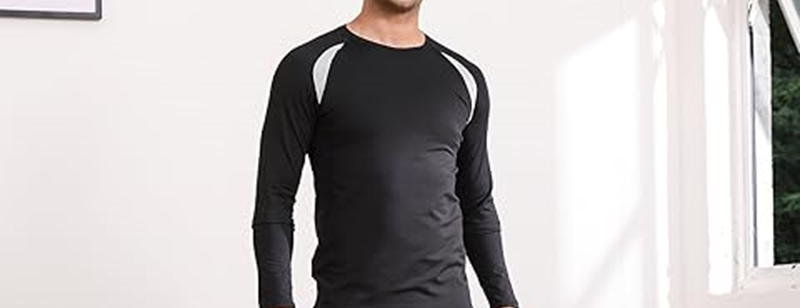Base layers are clothes that fit right against your skin, designed to keep you warm and wick away moisture. They are particularly beneficial in chilly environments or during activities such as running, cycling, or skiing. If you're buying your first baselayers, it's essential to focus on the materials as well as the fit and whether it's waterproof or not. Here's what you need to know about baselayer tops.
What's a Base Layer?
A base layer is the first piece of clothing you put on, acting like a ‘second skin’ to help regulate your body temperature, whether you need to stay warm or cool. Base layers and thermal underwear are designed to keep you cozy while also wicking away sweat, so you stay comfortable as you move around. This process is known as ‘wicking.’
Thermal clothing is versatile, available in various fabrics and styles to suit different weather conditions and activities. They’re usually made from synthetic materials and can be referred to as base layers, thermals, or compression wear. Typically, base layers and thermal gear come in two types: tops and bottoms. You can wear them under other clothes as part of a layering system or even on their own.
Base Layer Tops
Whether you’re hiking, walking, or climbing, having baselayer tops is essential, no matter the season. In warmer weather, short-sleeve shirts and vests are ideal for staying cool during your activities. Vests are the lightest option, followed by short-sleeve and long-sleeve tops.
When it’s cold, long-sleeve tops are usually the way to go, but short-sleeves can work too, depending on your activity. Longer sleeves help keep you warm and shield you from the elements, ensuring your blood circulation stays steady. Think about what you’ll be doing and what you’ll wear over your base layer before making a purchase.
Synthetic Base Layers
Synthetic base layers are usually the most affordable and widely available options in stores. These thermal layers are lightweight, dry quickly, and excel at wicking away moisture, making them ideal for high-energy activities. That's why you often see athletes sporting them during their workouts.
Just a heads up: synthetic fabrics are great for muscle compression, which is why you’ll spot compression shorts, sleeves, and vests in sports like football, rugby, basketball, and tennis. On the downside, synthetic materials aren’t naturally antibacterial, so they can hold onto sweat odours unless you wash them right away. Also, unless you opt for a warmer synthetic option, they don’t provide the same level of warmth as merino wool. So, keep that in mind when shopping.
Merino Wool Base Layers
Merino wool is the warmest option among base layer fabrics, making it a popular choice for thermal clothing. It helps regulate your body temperature, keeping you cozy without overheating—perfect for hiking. The tiny air pockets in the wool draw away excess heat while keeping warmth trapped inside the fibres.
Another plus: merino wool is naturally antibacterial, so it won’t hold onto body odours. Plus, the fibres are gentle on sensitive skin, unlike some synthetic materials. However, the main downside is that merino wool takes longer to dry compared to synthetics, and it can be pricier. Being a natural fibre, it might not wick moisture as effectively as synthetic layers, which makes it better suited for less intense activities like hiking and walking.
Silk Base Layer
Silk is super soft, making it a great choice for chill activities like a laid-back fall hike or an outdoor concert. It has moderate wicking; if you keep your heart rate in check, you should be good to go. Some silk underwear even has a special finish to help with moisture management.
Silk is lightweight and slides right under other layers, but keep in mind it’s not the toughest fabric out there. However, it doesn’t naturally resist odours, so you’ll want to wash it after each wear.
Should They Be Waterproof?
Base layers are made to keep you warm and pull sweat away from your skin, which is why they aren’t waterproof. Think of thermals and base layers as your second skin—they're the first part of your layering system. They’re super lightweight, so if you need something waterproof, you should look into actual waterproof gear like jackets, pants, and socks. The great thing about base layers and thermal wear is that you can use them all year long since they help manage your body heat, making them perfect for hikes in any weather.
Temperature Regulation
Base layers excel at both ventilation and breathability, allowing them to keep you cool in warm conditions while also providing warmth when temperatures drop. With the right base layers, you can effectively manage your body temperature and stay comfortable in any weather.
Moisture Management
One of the standout features of base layers is their moisture-wicking capability. This process involves transferring moisture away from your skin to the fabric, making wicking materials a favourite choice for athletic wear, as they help eliminate sweat and keep your skin dry.